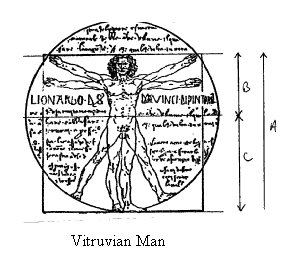- About MAA
- Membership
- MAA Publications
- Periodicals
- Blogs
- MAA Book Series
- MAA Press (an imprint of the AMS)
- MAA Notes
- MAA Reviews
- Mathematical Communication
- Information for Libraries
- Author Resources
- Advertise with MAA
- Meetings
- Competitions
- Programs
- Communities
- MAA Sections
- SIGMAA
- MAA Connect
- Students
- MAA Awards
- Awards Booklets
- Writing Awards
- Teaching Awards
- Service Awards
- Research Awards
- Lecture Awards
- Putnam Competition Individual and Team Winners
- D. E. Shaw Group AMC 8 Awards & Certificates
- Maryam Mirzakhani AMC 10 A Awards & Certificates
- Two Sigma AMC 10 B Awards & Certificates
- Jane Street AMC 12 A Awards & Certificates
- Akamai AMC 12 B Awards & Certificates
- High School Teachers
- News
You are here
Teaching Leonardo: An Integrated Approach - Questions for Students
Questions about Leonardo Da Vinci, the Golden Ratio, and Vitruvian Man
1
_______________|___________
x 1–x
The Golden Mean is the mean proportional between 1 and 1 – x. That is, we find the Golden Mean by solving the proportion 1:x = x:1-x for x.
1) Why is the Golden Ratio called the Divine Ratio?
2) Give two examples in ancient history where they used the Golden Ratio.
3) What is the approximate value of the Golden Ratio to the 5th decimal place?
4) What is the relation of the Golden Ratio to Fibonacci Numbers?
5) Leonardo worked with Fra Luca Paccioli to write the dissertation entitled Divina Proportione (The Divine Proportion). What are the 5 properties they said make this ratio divine?
6) On the reproduction of Leonardo’s Vitruvian Man, which was an illustration for the above dissertation, measure the ratio of the following, where E is the distance from the chin to the navel and D is the distance from the top of the head to the chin:
D/E =
E/B =
B/C =
C/A =

7) In Leonardo’s attempt at the Quadrature of the Circle, what is important about the center of the circle being the navel?
8) Find another web site dealing with Leonardo’s Vitruvian man, and write some other interesting facts about this drawing. In particular, determine other proportions in the drawing which seem to give the Golden Mean.
9) Measure a rectangle to see if the proportions fit closely to the Golden Mean (computer screen, credit card, window, white board, book, painting, calc screen, other…).
Questions about Leonardo Da Vinci and the Golden Mean
1) Reproduce the Golden Spiral using multiple Golden Rectangles in your Leonardo Notebook. (Remember that a square is added in counter clockwise fashion to the long edge of the previous rectangle.)
2) Number the length of each new long edge as the spiral grows as shown below.
3) List these numbers under the heading Fibonacci Numbers and calculate the ratio of the larger to the smaller consecutively as shown. Continue the pattern of numbers until you get to 1.618…..
Rick Faloon (The Ross School), "Teaching Leonardo: An Integrated Approach - Questions for Students," Convergence (June 2010), DOI:10.4169/loci002172




